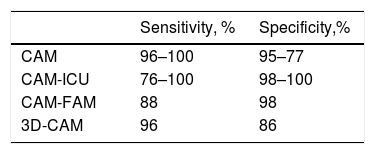Delirium, despite its high incidence, serious consequences and potential reversibility, remains an underdiagnosed syndrome. In patients with dementia, the healthcare professional may find significant difficulties in differentiating whether the patient presents cognitive alterations and behavioural disorders characteristic of dementia or, on the contrary, is faced with a delirium superimposed on dementia (DSD). In view of this difficulty, many tools have been proposed in recent years to improve the diagnosis of DSD in these highly complex patients. The aim of these tools is to be easy and quick to apply, and although focusing on assessing cognitive aspects such as attention or level of consciousness, some of them have also incorporated the assessment of other more novel aspects, such as the ability to respond to external stimuli (Arousal) or the degree of mobility.
El delirium, a pesar de su alta incidencia, graves consecuencias y potencial reversibilidad, sigue siendoun síndrome infradiagnosticado. En pacientes con demencia, el profesional sanitario puede encontrardificultades para diferenciar si el paciente presenta alteraciones cognitivas y trastornos conductualespropios de la demencia o, por el contrario, se encuentra ante un cuadro de delirium superpuesto a lademencia (DSD). Ante esta dificultad, se han propuesto en los últimos años distintas herramientas paramejorar el diagnóstico de DSD. Estas herramientas intentan ser fáciles y rápidas de aplicar, y a pesar decentrarse en la evaluación de aspectos cognitivos como la atención o el nivel de consciencia, algunas deellas han incorporado la valoración de otros aspectos más novedosos, como la capacidad de responder aestímulos externos (estado de alerta o activación) o el grado de movilidad.










